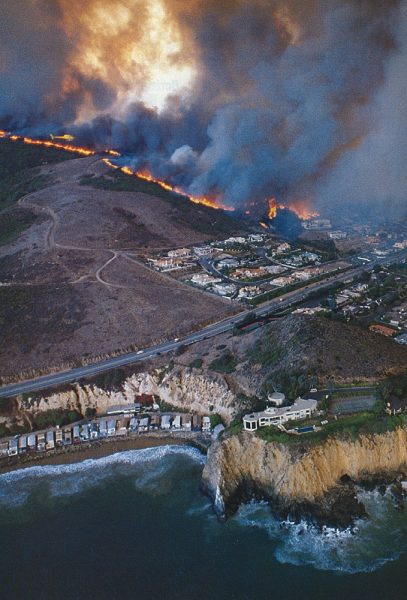Laguna Steps Up Disaster Preparedness
Posted On 12 Mar 2018
By Allison Jarrell, Special to the Independent

City officials want residents to be better prepared to cope with disasters such as the ’93 fire, seen here as its north advances around Irvine Cove.
The city of Laguna Beach is taking some significant steps to better prepare its residents and businesses for future natural disasters.
Besides creating a plan that formally identifies potential projects that will make the city more resilient in a disaster, the city’s first responders also launched a disaster preparedness campaign to encourage citizens to organize their own emergency plans and kits.
They aim to convince 3,000 residents to pledge to ready themselves for a future disaster by Oct. 27, the 25th anniversary of a wind-driven firestorm that devoured 440 Laguna Beach homes.
In February, the Laguna Beach City Council received a progress report on the new Local Hazard Mitigation Plan, which was initiated last year and is meant to provide a roadmap of projects for the city to undertake to improve its ability to withstand emergencies and natural disasters.
The city received a $99,375 grant from the Federal Emergency Management Agency last March, which paid for the consultant PlaceWorks, based in Santa Ana, to prepare the roadmap. Over the last six months, input has been gathered from two community forums and a Hazard Mitigation Planning Committee, as required under federal and state guidelines.
Jordan Villwock, the city’s emergency operations coordinator, and the police department lead the project, along with consultant Aaron Pfannenstiel.
Pfannenstiel said the planning process aims to ensure that the city’s hazard plans and documents are consistent. He noted that Villwock updates the city’s emergency operations plan daily, but the new plan’s five-year time frame focuses on actions to address vulnerabilities.
Areas of concern identified by the Hazard Mitigation Planning Committee include coastal hazards, such as erosion and sea level rise; wildfire; landslides and mudslides; seismic hazards; floods; human-caused hazards, such as infrastructure failure, nuclear hazards and terrorism; and disease and pest management.
Feedback from the two public workshops showed that nearly 85 percent of participants were most concerned about floods, wildfires, landslides and seismic hazards.
There are eight pages of potential mitigation actions listed in the draft LHMP aimed at addressing these hazards. The actions range from developing a major-event evacuation and shelter plan and a backup energy source for critical facilities, to undergrounding utilities and evaluating the city’s roads to identify potential bottlenecks during a major evacuation.
“When you read through this plan, it is very clear why we need to put the emphasis that we do on public safety, disaster preparedness, and particularly fire safety,” resident Matt Lawson, a member of the city’s Emergency Disaster Preparedness Committee, told the council.
Resident Jennifer Zeiter told the Council that while she doesn’t doubt that there are fire risks that need to be addressed, she also doesn’t want to see the plan become a “combined effort” to underground the city’s utilities.
“Before we rush to underground and spend a hundred and some odd million dollars on undergrounding utilities, why don’t we see if these safety plans have an impact? That’s what they’re intended to do,” Zeiter said.
Council member Toni Iseman said her experience consulting with other city officials at the National League of Cities’ convention showed that FEMA authorities are unwilling to consider grants to cities lacking their own hazard mitigation plan.
“This was the most important piece for us, to be in line for the money that was available, and hopefully will be available going forward,” Iseman said.
Pfannenstiel said community input will be incorporated where applicable and the plan submitted to the California Office of Emergency Services and FEMA for approval.
The document also requires City Council approval. Villwock said he anticipates the review process could be completed by May.
In addition to finalizing the hazard mitigation plan, city officials aim to make Laguna Beach the “Most Prepared City in Orange County.”
The city has partnered with its Community Emergency Response Team members with the goal of getting “as many households as possible to take the pledge towards emergency preparedness.”
In remembrance of the city’s worst disaster, the city has chosen a symbolic goal of getting 25 percent of Laguna Beach—or about 3,000 households—to take the pledge by Oct. 27.
In order to participate, residents need to make an emergency plan, create an emergency kit and sign an online pledge, which can be found at www.lagunabeachcity.net/getprepared. Online resources and checklists are also available at the city’s website.
Obtain more info on the campaign or mitigation plan by contacting Villwock at jvillwock@lagunabeachcity.net or (949) 497-0389.

No comments:
Post a Comment